
The Teloschistaceae are a large family of mostly lichen-forming fungi belonging to the class Lecanoromycetes in the division Ascomycota. The family has a cosmopolitan distribution, although members occur predominantly in temperate regions. Most members are lichens that either live on rock or on bark, but about 40 species are lichenicolous – meaning they are non-lichenised fungi that live on other lichens. Many members of the Teloschistaceae are readily identifiable by their vibrant orange to yellow hue, a result of their frequent anthraquinone content. The presence of these anthraquinone pigments, which confer protection from ultraviolet light, enabled this group to expand from shaded forest habitats to harsher environmental conditions of sunny and arid ecosystems during the Late Cretaceous.

Acarospora is a genus of mostly lichen-forming fungi in the family Acarosporaceae. Most species in the genus are crustose lichens that grow on rocks in open and arid places all over the world. They may look like a cobblestone road or cracked up old paint, and are commonly called cobblestone lichens or cracked lichens. They usually grow on rock, but some grow on soil (terricolous) or on other lichens. Some species in the genus are fungi that live as parasites on other lichens. Acarospora is a widely distributed genus, with about 128 species according to a 2008 estimate.

Variospora is a genus of crustose lichens, belonging to the family Teloschistaceae.

Gyalolechia is a genus of lichen-forming fungi belonging to the family Teloschistaceae. It contains 18 species of crustose lichens.

Athallia is a genus of lichen-forming fungi in the family Teloschistaceae. It was circumscribed in 2013 by Ulf Arup, Patrik Frödén, and Ulrik Søchting, and the type species is Athallia holocarpa. The genus name means "without a thallus".

Calogaya is a genus of lichen-forming fungi belonging to the family Teloschistaceae. It has 19 species. The genus was circumscribed in 2013 by Ulf Arup, Ulrik Søchting, and Patrik Frödén. The generic name Calogaya honours Dr. Ester Gaya, a Spanish botanist from the University of Barcelona.

Flavoplaca is a genus of crust-like or scaly lichens in the family Teloschistaceae. It has 28 species with a mostly Northern Hemisphere distribution.

Xanthocarpia is a genus of mostly crustose lichens in the family Teloschistaceae. It has 12 species with a largely Northern Hemisphere distribution.
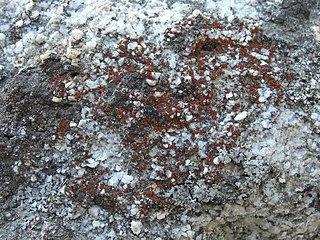
Rufoplaca is a genus of lichen-forming fungi in the family Teloschistaceae. The genus was circumscribed in 2013 by Ulf Arup, Ulrik Søchting, and Patrik Frödén, with Rufoplaca subpallida assigned as the type species.
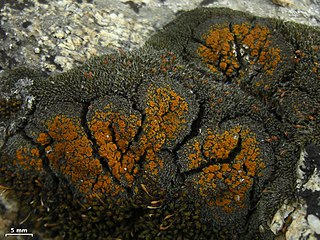
Parvoplaca is a genus of lichen-forming fungi in the family Teloschistaceae. The genus was circumscribed in 2013 by Ulrik Søchting, Patrik Frödén, and Ulf Arup.
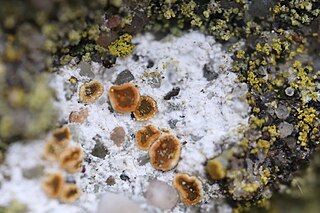
Kuettlingeria is a genus of saxicolous (rock-dwelling), crustose lichens in the family Teloschistaceae. Species are characterized by a white or gray thallus and the presence of anthraquinones in the apothecial disc and true exciple, with the exception of Kuettlingeria diphyodes, which entirely lacks anthraquinones. First described by Italian botanist Trevisan in 1857, the genus includes 15 recognized species, although it is believed to be more diverse with additional unnamed species. These lichens are predominantly found in the Northern Hemisphere, particularly in the Mediterranean region, and grow on limestone and base-rich siliceous outcrops in sunlit conditions.

Pyrenodesmia is a genus of lichen-forming fungi in the family Teloschistaceae. The genus currently includes 23 recognized species but is believed to contain many more unnamed taxa. The genus was circumscribed in 1852 by Italian lichenologist Abramo Bartolommeo Massalongo. It is characterised by the complete absence of anthraquinones and the presence of Sedifolia-gray pigments in both the thallus and apothecia. These lichens are typically found in calcareous outcrops in the Northern Hemisphere, with biodiversity centres in the Mediterranean basin, Central Asia, and arid regions of western North America.
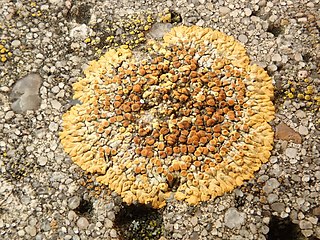
Calogaya pusilla is a species of saxicolous (rock-dwelling), crustose lichen in the family Teloschistaceae. It was originally formally described in 1852 by Italian lichenologist Abramo Bartolommeo Massalongo, who placed it in genus Physcia. The type specimen was collected in Veneto, Italy. It has undergone several changes of genus in its taxonomic history, including transfers to Caloplaca, Placodium, and Teloschistes. In 2013, it was placed in the newly circumscribed genus Calogaya.
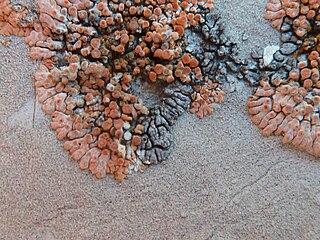
Calogaya arnoldii is a species of saxicolous (rock-dwelling), crustose lichen that is common and widespread in Europe and Asia. It is in the family Teloschistaceae. It was first formally described as a new species in 1876 by Hugh Algernon Weddell, as a species of Lecanora. After being transferred to Caloplaca in 1915, it was considered as a member of that genus for nearly a century. Molecular phylogenetic studies showed Caloplaca to be polyphyletic, and it was divided up into several smaller genera in 2013. Calogaya arnoldii was one of eight species transferred to the newly circumscribed Calogaya by Ulf Arup, Patrik Frödén, and Ulrik Søchting. The lichen is part of a species complex with complicated taxonomy, and in which intermediate phenotypes are frequently observed, making it difficult to reliably distinguish them. Calogaya saxicola is one such similar species, and it has often been confused with C, arnoldii in areas where they co-occur, as the differences between them are subtle.
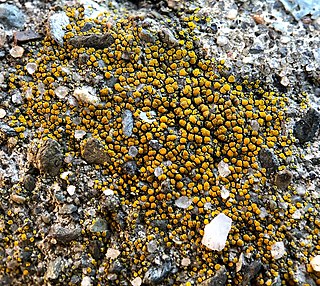
Xanthocarpia feracissima is a species of saxicolous, crustose lichen in the family Teloschistaceae. It was first formally described as a new species in 1953 by Swedish lichenologist Adolf Hugo Magnusson, as a member of the genus Caloplaca. The type specimen was collected in 1939 by John Walter Thomson in Lake Koshkonong, Wisconsin. In the original description, Magnusson notes a similarity to the lichen now known as Gyalolechia flavovirescens, but distinguishes the new species by its lack of a visible thallus, the sordid-reddish color of its discs, and the "unusually narrow" septa of the spores. Patrik Frödén, Ulf Arup, and Ulrik Søchting transferred the taxon to Xanthocarpia in 2013, following molecular phylogenetic analysis of the family Teloschistaceae.

Xanthocarpia crenulatella is a species of saxicolous (rock-dwelling), crustose lichen in the family Teloschistaceae.
Orientophila is a genus of lichen-forming fungi in the family Teloschistaceae. It has 15 species of mostly saxicolous (rock-dwelling), crustose lichens. All Orientophila species occur in Northeast Asia including China, Japan, South Korea, and the Russian Far East.
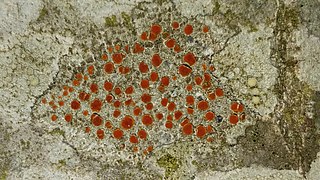
Blastenia ferruginea is a species of corticolous (bark-dwelling), crustose lichen in the family Teloschistaceae. It has a cosmopolitan distribution.
Kuettlingeria neotaurica is a species of saxicolous (rock-dwelling), crustose lichen in the family Teloschistaceae.

















